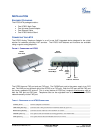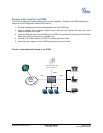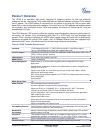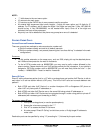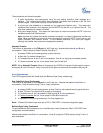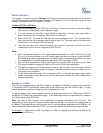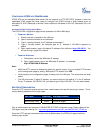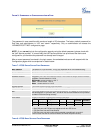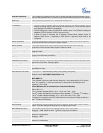
1. A presses FLASH (on the analog phone, or Hook Flash for old model phones) to get a dial
tone.
2. A dials C’s number then # (or wait for 4 seconds).
3. If C answers the call, then A presses FLASH to bring B, C in the conference.
4. If C does not answer
the call, A can press FLASH back to talk to B.
5. If A presses FLASH during the conference, C will be dropped out.
Note: Party A is the call initiator for both calls with party B and party C.
PSTN PASS THROUGH
HT503 supports PSTN pass through using the FXS port. The user can place and receive PSTN calls
when the FXS port is in use.
• To receive PSTN calls, pick up the phone when it rings;
• To complete a PSTN call, press the PSTN access code (*00 is default, or any number configured
in the web configuration) to switch to the PSTN line, listen for a dial tone, then dial the number.
•
It the HT503 loses power, it will function as a jack, enabling a direct connection to the PSTN Line.
VOIP-TO-PSTN CALLS
This function is available using the FXO port. The FXO port functions as a bridge between the Internet
and PSTN. The user can remotely use a PSTN line to initiate a call.
T
O MAKE A VOIP-TO-PSTN CALL:
1. Dial the FXO SIP account phone number to establish the VoIP session. The caller will hear the
ring back tone once
. Then the caller hears either a special continuous tone or a dial tone. The
special continuous tone is played if the pin code is configured, otherwise, the caller will hear a dial
tone.
2. Enter the pin code (configured on the configuration page). The caller will hear a dial tone and be
connected to the PSTN line if the pin code is valid. If the pin code is invalid, the continuous tone
is played to prompt caller to enter the pin code again. The user may try up to 3 times to enter a
correct pin code. After three (3) tries, the HT503 hangs up.
3. After the caller hears a dial tone from PSTN line, the caller can place the next call.
4. The user can hit the # key to identify the end of the pin code or wait 4 seconds for a new dial tone
and then dialing the PSTN number.
Note:
• Users can choose whether or not to apply password protection for VoIP-to-PSTN calls. A PIN
(Pin for PSTN calls) consists of up to 8 numeric digits and can be configured using the BASIC
SETTINGS of the web configuration page. By default, there is no password protection. (I.e. there
is no authentication required for callers on the use of PSTN line through HT503).
• When a PIN is configured for VOIP-to-PSTN call flow, the VoIP device that calls into the HT503
FXO account needs to configure RFC2833 or SIP Info for DTMF digit transmission.
• The special continuous tone is the prompt to enter a valid PIN code. If a caller doesn’t enter a
valid PIN, the HT503 times out after 10 seconds. Users may press the “#” key to indicate the end
of an input or wait 4 seconds.
• On the web configuration page, if the “Forward to PSTN” is configured, the second stage dialing
format is eliminated, so after dialing into the FXO SIP account number, the PSTN number will be
called automatically
Grandstream Networks, Inc. HT503 User Manual Page 13 of 35
Firmware 1.0.0.6 Last Updated: 6/2007



